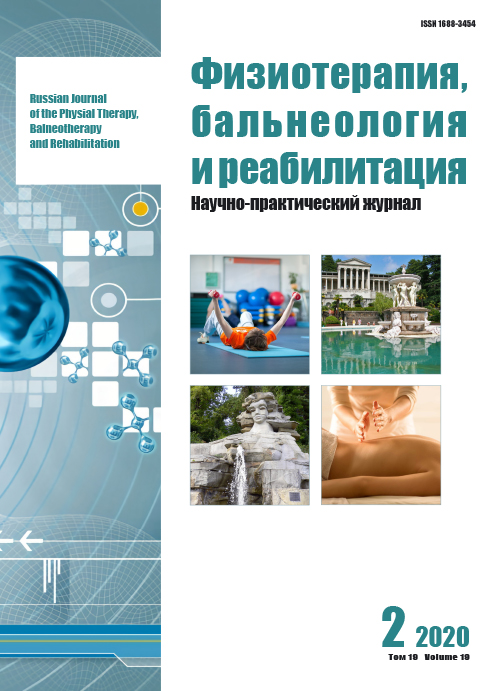Application of modern non-drug technologies for the full formation of postoperative scar in patients after plastic surgery for rectocele
- Authors: Zhumanova E.N.1
-
Affiliations:
- Центральная государственная медицинская академия Управления делами Президента Российской Федерации Клиническая больница № 1 Управления делами Мэрии и Правительства Москвы в Отрадном (МЕДСИ)
- Issue: Vol 19, No 2 (2020)
- Pages: 107-115
- Section: Original studies
- Published: 15.06.2020
- URL: https://rjpbr.com/1681-3456/article/view/56999
- DOI: https://doi.org/10.17816/1681-3456-2020-19-2-7
- ID: 56999
Cite item
Abstract
Background. In recent decades, various physiotherapeutic methods have been widely used in surgical practice in order to obtain an anti-inflammatory and bactericidal effects, accelerate reparative and regenerative processes, and improve microcirculation in the postoperative area.
Aim: to develop and scientifically substantiate optimized complex programs, including general magnetotherapy, fractional microablative therapy with a CO2 laser, electrical myostimulation with the biological connection of the pelvic floor muscles and a special complex of physiotherapy exercises (exercise therapy) in patients of different age groups after reconstructive plastic surgery for rectocele.
Methods. The article presents data on treatment of 160 women of childbearing, peri- and menopausal age with rectocele of II–III degree. Patients after surgical treatment of rectocele, in the late postoperative period for the full formation used rehabilitation programs, including in various combinations of General magnetotherapy, electromyostimulation with biological connection of the pelvic floor muscles, procedures of intra-vascular fractional microablative therapy with CO2 laser and a special complex of therapeutic physical education.
Results. As a result of the research, it was found that when combined with General magnetotherapy, fractional microablative CO2 laser therapy, electromyostimulation with biological connection of the pelvic floor muscles, and a special complex of physical therapy in patients after plastic surgery for rectocele, a pronounced trophostimulating effect is formed, to a greater extent in patients with peri- and of menopausal age, which is particularly important, as they have in the background of the age hypoestrogenia perimenopausal and postmenopausal women marked atrophy.
Conclusions. Complex treatment that promotes proper formation of postoperative scar by improving microcirculation and thickening of the dermis and mucosa, endometrium, submucosa and connective tissue, as confirmed by the ultrasound scan.
Full Text
About the authors
E. N. Zhumanova
Центральная государственная медицинская академия Управления делами Президента Российской ФедерацииКлиническая больница № 1 Управления делами Мэрии и Правительства Москвы в Отрадном (МЕДСИ)
Author for correspondence.
Email: ekaterinazhumanova@yandex.ru
ORCID iD: 0000-0003-3016-4172
Russian Federation
References
- Apolikhina IA, Dodova EG, Borodina EA, et al. Pelvic floor dysfunction: modern principles of diagnostics and treatment. Effective pharmacotherapy. 2016;(22):16-23. (In Russ).
- Epifanov VA, Korchazhkina NB. Medical rehabilitation in obstetrics and gynecology. Moscow: GEOTAR-Media; 2019. 504 p. (In Russ.)
- Kurdina MI, Makarenko LA, Markina NYu. Ultrasound diagnostics in dermatology. Russian Journal of Skin and Venereal Diseases; 2009;(4):11-15. (In Russ.)
- Shtirshnaider YuYu, Michenko AV, Katunina OR, Zubarev AR. Modern non-invasive imaging technologies in dermatology. Bulletin of Dermatology and Venereology. 2011;(5):41-53. (In Russ.)
- Adhikari S, Blaivas M. Sonography first for subcutaneous abscess and cellulitis evaluation. J Ultrasound Med. 2012;31(10):1509-1512.
- Wortsman X. Common applications of dermatologic sonography. J Ultrasound Med. 2012;31(1):97-111. doi: 10.7863/jum.2012.31.1.97.
- Bezugly AP, Bikbulatova NN, Shuginina EA, et al. Skin ultrasound examination in the cosmetologists practice. Vestnik dermatologii i venerologii. 2011;(3):142-152. (In Russ).
- Kruglova LS, Kotenko KV, Korchazhkina NB, Turbovskaya SN. Fizioterapiya v dermatologii. Moscow: GEOTAR-Media; 2016. 303 p. (In Russ).
- Crişan M, Crişan D, Sannino G, et al. Ultrasonographic staging of cutaneous malignant tumors: an ultrasonographic depth index. Arch Dermatol Res. 2013;305(4):305-313. doi: 10.1007/s00403-013-1321-1.
- Kleinerman R, Whang TB, Bard RL, Marmur ES. Ultrasound in dermatology: principles and applications. J Am Acad Dermatol. 2012;67(3):478-487. doi: 10.1016/j.jaad.2011.12.016.
- Тalybova AP, Stenko AG, Korchazhkina NB. Innovative technologies in the treatment of combined cicatrical skin changes. Fizioterapevt. 2017;(1):47-55. (In Russ).
- Badea R, Crişan M, Lupşor M, Fodor L. Diagnosis and characterization of cutaneous tumors using combined ultrasonographic procedures (conventional and high resolution ultrasonography). Med Ultrason. 2010;12(4):317-322.
- Wortsman X. Sonography of facial cutaneous basal cell carcinoma: a first-line imaging technique. J Ultrasound Med. 2013;32(4):567-572. doi: 10.7863/jum.2013.32.4.567.
- Wortsman X, Wortsman J. Sonographic outcomes of cosmetic procedures. Am J Roentgenol. 2011;197(5):W910-918. doi: 10.2214/AJR.11.6719.
- Mandava А, Ravuri PR, Konathan R. High-resolution ultrasound imaging of cutaneous lesions. Indian J Radiol Imaging. 2013;23(3):269-277. doi: 10.4103/0971-3026.120272.
Supplementary files







